For those short on space but with piano passion, there are more baby grand piano options than ever before.
A baby grand can be the perfect balance of space and performance. Still, the biggest challenge for those looking for a great piano is being able to see competitors side by side.
In this review, we are comparing three premium pianos inspected by a piano expert in real world conditions. The manufacturers had no way of knowing their pianos were going to be evaluated for a review. Our expert did not perform any service work on the pianos, evaluating them as the builder presented them. We assume they put their best work on display.
Bosendorfer Model 155
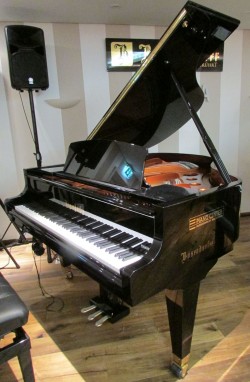
Bosendorfer Mignon Baby Grand
Austrian builder Bosendorfer has enjoyed a reputation for producing a quality piano. However, many wondered about the company’s fate after being acquired by Yamaha in 2008. Would the reputation be upheld or would the standards be lowered to those of a mass produced piano?
Despite their difficulty building a baby grand in the past, the Mignon was introduced in 2012.
Fazioli Model F156
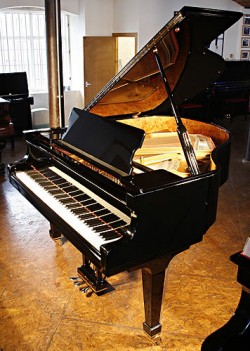
Fazioli F156 Baby Grand
While often dismissed as the piano of the nouveau riche since its appearance in the movie “50 Shades of Gray,” Fazioli is not without its merits. This Italian builder’s small production, the trendy nature of the brand, and Fazioli’s much higher price tag has created a bit of a mystique about the brand.
But do they live up to the hype? Does real life mirror the fantasy when the finger strikes the key?
Steinway & Sons Model S (155)
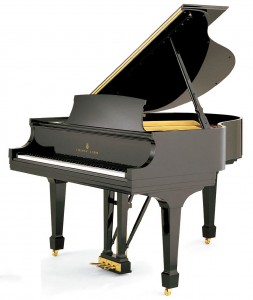
Steinway & Sons Model S Baby Grand
Steinway & Sons baby grand has been the go to choice for those who need big piano performance in a small space since the model was introduced in 1936. With several improvements being incorporated over the decades, the New York and Hamburg built pianos have dominated their market for well over a century.
The iconic piano builder also has a new owner. With nearly two thousand artists staking their reputations and livelihood on the performance of the Steinway piano, the stakes could not be higher. More than two years since the purchase, the pianos we see now were produced under the leadership of the new owner.
Our tests consider the three most important elements of a piano;
- Likability – a combination of sound and how the piano responds to the player’s touch. In other words, how fun is the piano to play?
- Construction – an overview of the design, materials, and craftsmanship of the piano to give us an idea of how the pianos will hold up
- Finish – the attention to how the piano looks as a piece of furniture
Likability
Playing the Fazioli is a different experience for most players the first time, although our reviewer found it reminiscent of something that was difficult to pinpoint initially. It was familiar, but not like a traditional piano. The touch is responsive, made using a good quality action by Renner, the same company who makes actions for Steinway & Sons’ upright pianos. The sound was clear initially, yet less natural as the notes decayed.
After playing awhile, the familiarity was discovered to be that of a high-end digital piano. As the piano sustained, the tone sounded engineered, with a noticeable “twang” in the higher registers and “rolling boom” in the bass, which digital pianos often tweak to offer a “pop music” sound. The bass, while powerful, sounded similarly artificial the longer the reviewer listened. Again, this made the piano sound different from other pianos, but soon one could only think about how much the piano sounded like the Roland V-Piano, which costs about a quarter of the smallest Fazioli and has other instruments built in.
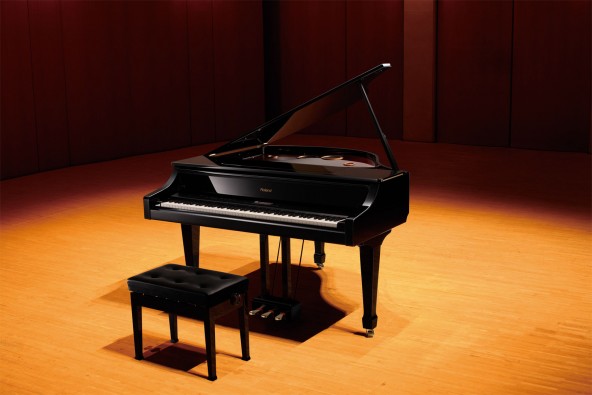
Roland V Grand Piano
The Steinway demonstrated the remarkable ability to feel natural right from the start. The action, which is exclusive to and built by Steinway & Sons in their factory, was excitingly intuitive. More challenging pieces were easier to play. Less attention was needed to thinking about one’s technique. It was as if the piano knew what the player was thinking, making it very easy to get lost in the music.
The sound is natural, as if it streams out of the instrument effortlessly. The highs are clear and bell-like with a warm, subtle omnidirectional growl in the lower notes.
Most surprising was the Bosendorfer. It, too, reportedly uses the Renner action, but was the least fun to play, as if there was a disconnect between touch and sound. The tone came across as muffled and muted unless the piano was played very hard, which made it less dynamic and difficult to enjoy.
Construction
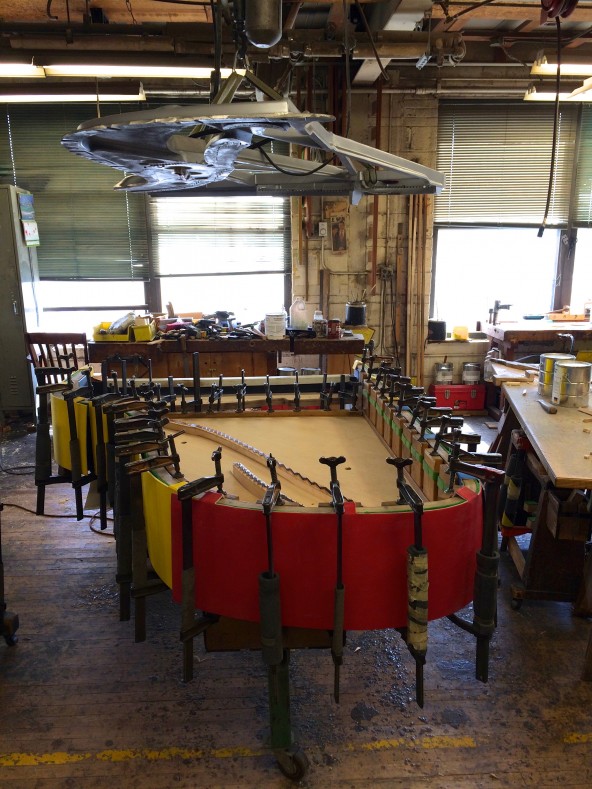
Steinway grand piano during construction
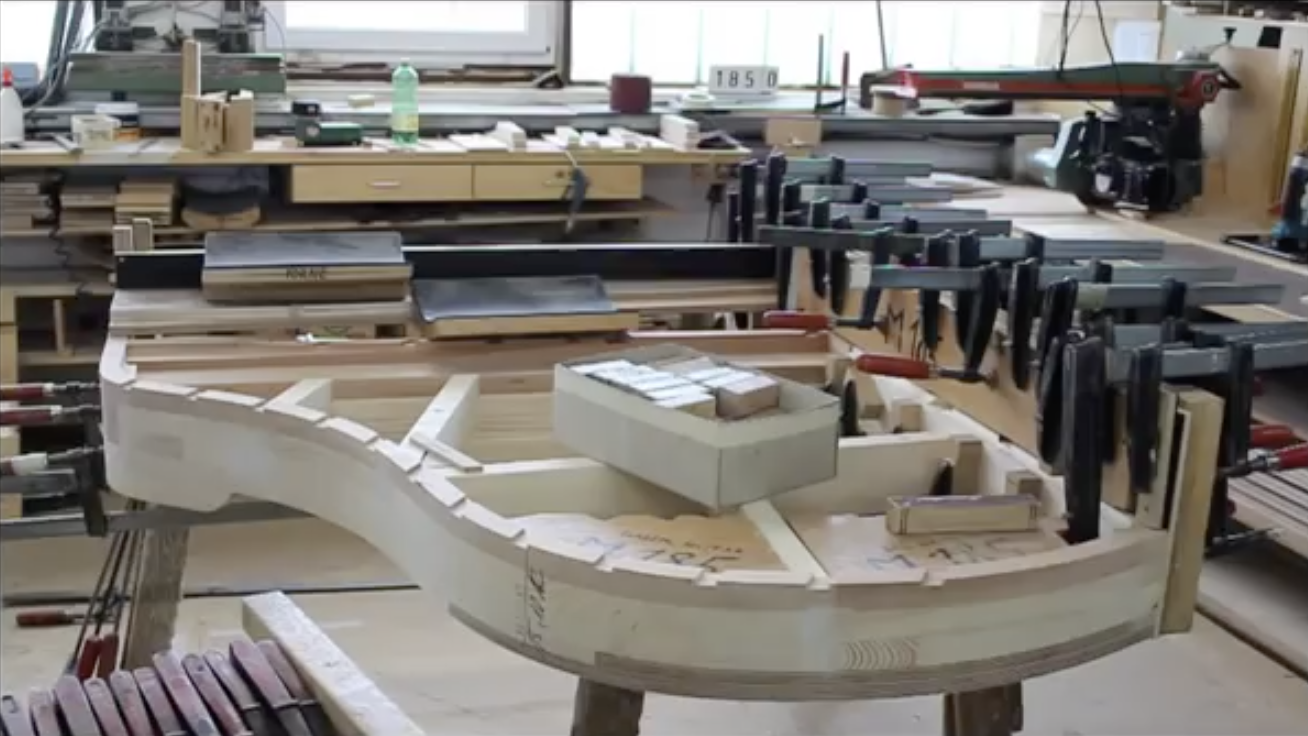
Bosendorfer piano during construction. Unlike the Steinway’s single-molded frame, note the absence of the outer rim, which will be glued on later.
Investing in a smaller piano at this level should mean no sacrifice in overall quality. Construction is rated based on how similar the quality of each baby grand is to that builder’s larger instruments and the overall choice of materials, design, and craftsmanship.
An inside and out inspection of the Steinway revealed a machine that, other than its size, is indistinguishable from their famed Model B and Model D pianos.
A very nice touch in their newer pianos is how they reveal certain construction features. Most notably is the one piece continuous bent inner and outer rim. Steinway is the only builder who makes both rims of the piano as one, using Hard Rock Maple, which is one of the reasons their pianos last for generations. Other builders add the outer rim after building the rest of the piano, like a furniture piece as opposed to part of the foundation of the instrument. Looking under a Steinway of any size, it is easy to see each layer of maple!
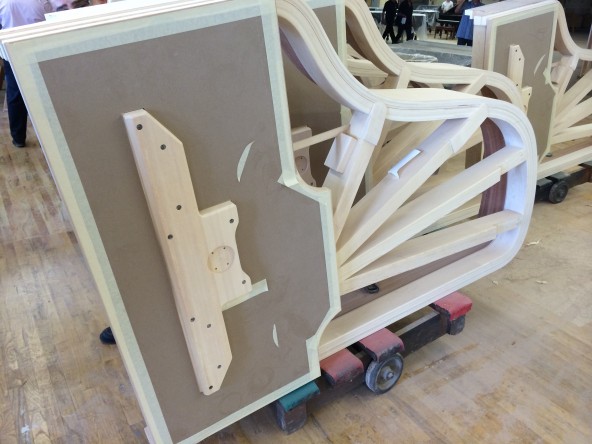
Underside of a Steinway grand piano during construction. All braces come to one point on the crossblock for strength. Each layer of the one piece rim is visible. The keybed is built as part of the case, attached using woodworking techniques, making the case even stronger.
From the consistency in the grade and color of the Sitka spruce soundboards to the jointing of braces to the rim, the pride that Steinway & Sons takes in building their pianos to one consistent standard shines through.
The Bosendorfer appeared to be built more like their Model 280 than the Model 290 Imperial grand that they are best known for. These newer models all appear to be based on designs introduced after the Yamaha acquisition. Because these are new designs, no opinion can be offered as to whether they will have lifespans like their time tested 225 and 290 models or more like the Yamaha models.
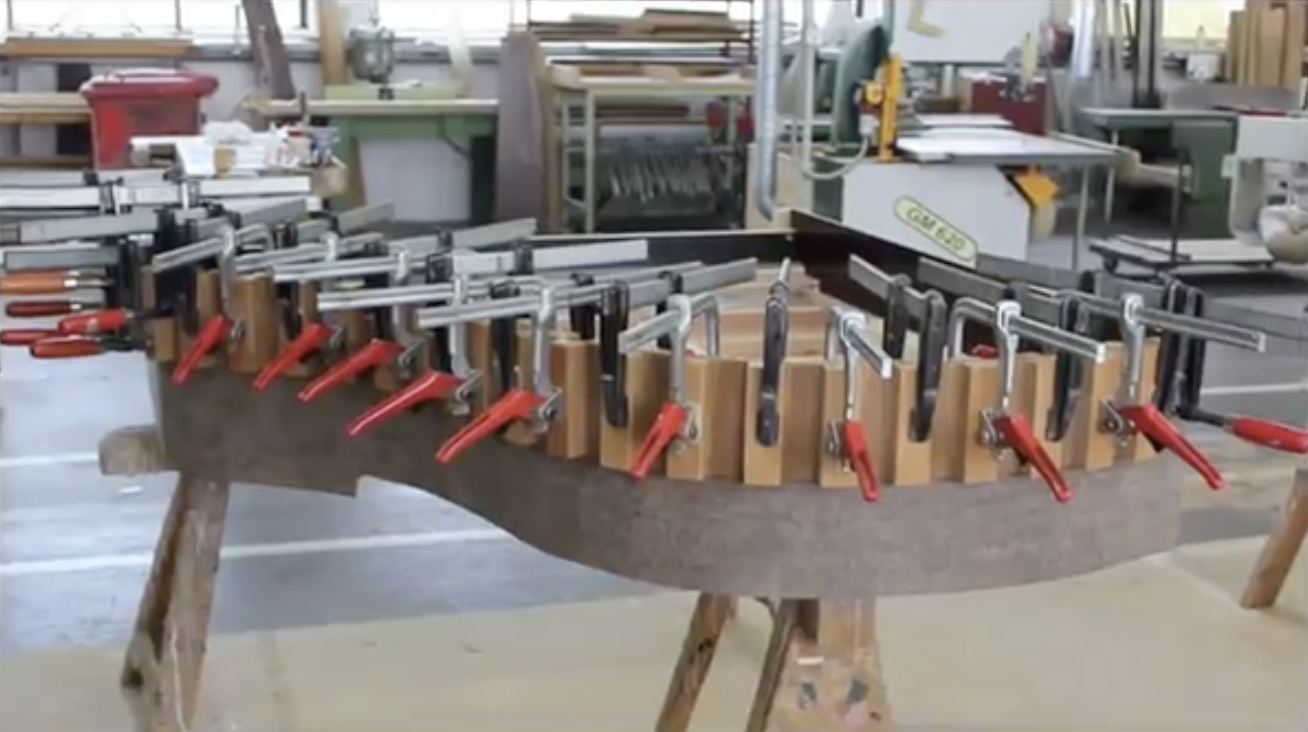
Bosendorfer piano after the outer rim is glued on. Instead of using a rim press, the rim is simply clamped in place and glued. This method results in a rim that does not contribute to the strength of construction, and functions only as a decorative trim.
The Fazioli was as consistent with its bigger brothers as was the Steinway baby grand. From a design standpoint, Fazioli takes a different approach in all of their grands, using radial bracing from the middle to the bass section of the piano with the higher tension treble section bracing alone and off center of the crossblock. In our opinion, it seems to be an engineering risk.
In construction, the builder also incorporates some of the cost saving measures of mass produced pianos, including using screws that can come loose to reinforce the frame, two piece rims, and screws to attach the keybed onto the bottom of the frame. Still, these are differences in design between the brands, not differences between the smaller and larger Fazioli. Because the brand is still in its infancy, there are no seasoned examples of Fazioli pianos like there are Steinway & Sons and Bosendorfer. No opinion can be offered as to the long term durability of these pianos in home or institutional environments.
Finish
The sample Bosendorfer that was examined was finished fairly well, but not to the level one would expect from a premium piano. At these price points, one expects attention to detail. Most noticeable were uneven finish lines and some splattering. This may be better or worse from one to the next, but anyone seriously considering the piano should inspect it thoroughly and under a variety of lighting before accepting. We would not recommend ordering one sight unseen.
Beyond these details, the Bosendorfer has a hulking appearance that may be attractive on its larger scale brothers but appeared on the baby as if it might tip over at any moment. The legs appear machine cut, with a severe taper that clashes with the delicate looking lyre and points to casters that are way too big. The music desk and prop stick look like simple machine cuts and, while functional, are quite boring and inconsistent with the legs and lyre.
The Fazioli looked more balanced, as if to pay homage to the Steinway baby grand, although with a heavier looking leg. Its music desk, lid, lyre, and prop stick appeared to be machine done and the prop in particular clashed with the legs and lyre.
Steinway has obviously taken pains to scale their smaller pianos from larger ones, making each model look proportional. The curve of the Steinway lid is consistent with those of the music desk and cello inspired prop stick. There is a subtle taper to the lyre that mimics the legs, which meet the floor with an appropriate size solid brass caster that makes the piano appear to float subtly just above the floor.
Detail to the hand lettering of the plate and even the placement of string gauge markings was exquisite – as one would expect from an instrument that is hand built.
Conclusion
If these pianos were all priced the same, the Steinway Model S would be the clear winner. It is fun to play, built to the same standards as their concert grands, and the builder has a long history of producing pianos that appreciate in value and outlast their owners.
However, these pianos are not priced the same.
At nearly double the price of the Steinway, the Fazioli gave us the impression that the Italian builder designed their baby to persuade us to buy their much larger pianos. The Bosendorfer performed about as well as some of the pricier Yamaha pianos that we have played. With a price tag between the Fazioli and the Steinway, our opinion is that buying the Bosendorfer would be paying a huge premium for the name.
In their era of new ownership, Steinway & Sons has figured out how to make a better baby grand. They have redefined the Model S with more attention to detail that ever before. It is the most inspiring baby grand that we played, is built to their highest standards ever and the highest standards of any brand we tested, and looks gorgeous.
If you want the best baby grand piano, invest in the Steinway & Sons Model S. If you really want to spend the six figure price tag of the Fazioli, get two S models!
Have you played two or more of these pianos? Leave us a reply and let us know what you think.
Because manufacturer policies prevent us from printing prices, we only use price and value comparisons. We are not able to respond to questions about specific prices of pianos.
In the interest of fairness, we first referenced pianos in alphabetical order by brand, then rotated the position throughout the article.
I have a Steinway and I am very happy with it. That said, I wonder what are the qualifications of the expert who says that the Fazioli sound is comparable to a digital piano. The only objective statement in the review is that Steinways have been around for decades and one can tell how they age, while the Faziolis are of more recent introduction. Everything else seems to be not objective expertise but personal preferences. I would suggest that to be honest about the sounds of these instruments, one should put the three pianos in the same recording studio, have the same piece played on each of them by the same pianist, and then ask the experts to identify which piano is in each recording.
It is nice to get some background on why the pianos are different. Usually Blogs just say this is better or that is better. I liked this review. Good explanations.
One of the most objective reviews I have seen. Radial bracing being superior is just engineering fact. A one piece rim is just stronger in every way. Sound will always be objective, but why would anyone spend this kind of money on a piano unless there was proof it was going to last. Steinway continues to earn their stripes!
Thank you for posting a helpful review.
I have a rebuilt 1936 Steinway S. As a musician I play many pianos most of them bigger. When I come back to my piano I always think wow this piano sounds, plays and looks great. I think they did a wonderful job designing the model S.
I try Steinway and Bosendorfer and Steinway was much better, the sound is so beutifull.
The touch is perfect. Finally I buy it!!!!